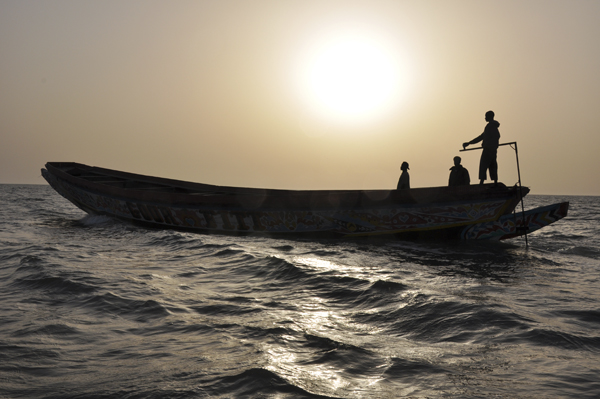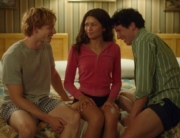
THE PIROGUE, directed by Moussa Touré (ArtMattan Productions)
The Pirogue feels ripped from the headlines of Africans plucked from the ocean, dead or alive, trying to make it illegally into Europe, even now during the recession. Senegalese director Moussa Touré gives us the sympathetic perspective of those who take that risky journey, and relives what it’s like for his countrymen who travel almost a thousand miles from West Africa to Spain’s Canary Islands.
With elaborate rituals that incorporate religious traditions from animist to Muslim, the opening scene celebrates Senegalese culture in an arena for the national sport, wrestling. The match attracts a broad audience, from older traditionalists to young men with iPods, but the nearby ocean beckons them all. For Baye Laye (Souleymane Seye Ndiaye), who is almost as physically imposing as the wrestlers, the ocean provides him a living as a fisherman to support his wife and son. He captains a deep bottomed wooden boat, called a pirogue, as beautiful as it is functional, so colorfully painted and carved that it looks straight out of a museum display of how ancient peoples crossed from the old world to the new.
But with the catches thinning, anyone with boating skills is tempted to work for smugglers piloting desperate people from the third world to the first, for a trip that should only take seven days—Baye Laye’s young, inexperienced assistant, Kaba (Babacar Oualy), doesn’t even think to check the equipment and supplies. But when Baye Laye’s younger brother, Barry (Salif Diallo), lets him know he’s going, too—like thousands of young men who feel they have no opportunity in Senegal—Baye Laye feels responsible to get him there safely and agrees to captain the trip.
A key element in the film’s realism is the tribal and linguistic diversity so often ignored in films about Africans made by outsiders. The smuggler, Lansana (Laïty Fall), has contracted with groups reflective of Senegal’s dozens of ethnicities, including inland Guineans, who have no seafaring experience, and Hal Pulaars, who not only don’t speak the same language but have different priorities, religions, and culture. (In addition to the chants and dances of the passengers that reflect their moods, the beautiful score by Prince Ibrahima N’Dour, a member of Youssou N’Dour’s band, also includes songs by a variety of Senegalese musicians.)
By necessity, the passengers and crew manage to cooperate in the face of ever increasing crises, but the intergroup tensions are exacerbated when the infuriated smuggler realizes that a stowaway has sneaked on board. Some just want to make enough money to send home to their families, one is a musician joining a band in Paris, another wants to play on a professional soccer team, a man on crutches wants an artificial leg, all of which add to the viewers’ investment in what will happen to them.
The trip begins with some modern conveniences—Baye Laye has a GPS to drive his engine, and one man listens for news on a radio—but then the elements take over. (The crew watched Peter Weir’s Master and Commander: The Far Side of the World for guidance on being thrown back to olden days on the open sea.) The weather is almost as relentless as in that 2003 historical epic, with the smaller scale scarier and more intimately harrowing as each passenger deals with the heat, rain, rolling waves, and the resulting equipment failures and loss of food and water. One man has such severe panic attacks that his compatriots have to tie him up and gag him to stop his moans from bothering the others. (The fear on the actors’ faces is real—many of them didn’t know how to swim.)
Most challenging are the ethical dilemmas they face and debate, from sharing food and pills to considering the pleas of another stranded boat for assistance, causing the decisions they make to haunt them as bad omens and spiritual retribution. With the terrible news stories of pirates and traffickers trolling the seas, the audience even dreads sightings of possible rescuers, let alone the sorrow of what will happen to the survivors next. While several features, such as Maggie Peren’s Color of the Ocean (2011) and Eliane de Latour’s Beyond the Ocean (2006), have sensitively shown the daunting struggles of African immigrants once they’ve somehow made it to Europe, Touré memorably captures the staggering determination it takes to step foot on those shores.






Leave A Comment